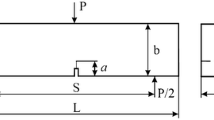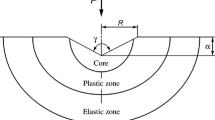Abstract
The dominant mechanical failure mechanism in brittle or quasi-brittle materials is cracking, and the parameters that characterize the fracture process of a given material are the extension of cracked region as a function of externally applied load and the resistance of the deforming material to the advance of cracking, also known as fracture toughness. In the present investigation we develop and demonstrate a technique for observing and studying the process of macroscopic crack initiation and propagation, and for determining the fracture toughness of the brittle or quasi-brittle materials. We will address issues such as specimen design using only small amount of material, loading configuration that can generate stable crack growth in brittle solids, diagnostics for identifying crack initiation and quantifying the extent of crack growth, and scheme for extracting the stress intensity factor at the tip of a growing crack. The technique described is applied to the brittle material graphite.


















Similar content being viewed by others
References
Addessio F, Mohan N, Luscher D, Morrow B, Cawkwell M, Liu C, Meredith C, Ramos K (2020) A single-crystal model for the deformation of cyclotrimethylene trinitramine including plastic slip, crack growth and crack friction. Los Alamos National Laboratory Report, LA-UR-20-21101. Submitted to J Appl Phys
Dondeti S, Tippur H (2020) A comparative study of dynamic fracture of soda-lime glass using photoelasticity, digital image correlation and digital gradient sensing techniques. Exp Mech 60:217–233
Liu C, Thompson D (2012) Deformation and failure of a heterogeneous high explosive. Philos Mag Lett 92:352–361
Liu C, Thompson D (2014) Crack initiation and growth in PBX 9502 high explosive subject to compression. J Appl Mech 81:101004
Liu C, Thompson D (2015) Mechanical response and failure of high performance propellant (HPP) subject to uniaxial tension. Mech Time-Depend Mater 19:95–115
Liu C, Thompson D, Lovato M, Deluca R (2010) Macroscopic crack formation and extension in pristine and artificially aged PBX 9501. In: Proceedings of the 14th international detonation symposium, Coeur d’Alene
Liu C, Rae P, Cady C, Lovato M (2011) Damage & fracture of high-explosive mock subject to cyclic loading. In: Proulx T (ed) Mechanics of time-dependent materials and processes in conventional and multifunctional materials, vol 3. Conference proceedings of the society for experimental mechanics series. Springer, New York
Liu C, Cady C, Ramos K (2018a) Fracture toughness measurement of PBX 9502 high explosive. In: Proceedings of the 16th international detonation symposium, Cambridge, pp 226–235
Liu C, Cady C, Ramos K (2018b) Quantitative investigation of fracture process in brittle/quasi-brittle solids. In: Proceedings of the 16th international detonation symposium, Cambridge, pp 1614–1623
Liu C, Meredith C, Morrow B, Cady C, Ramos K (2019a) Dynamic deformation of RDX single crystal using miniature SHPB and high-speed photography. In: Conference proceedings of the society for experimental mechanics series, Reno, pp 143–148
Liu C, Thompson D, Woznick C, Yeager J, Duque A, DeLuca R (2019b) PBX 9501 versus a new thermomechanical density mock: Brazilian disk compression test comparison. In: AIP Conference proceedings, the 21st biennial APS shock compression of condensed matter (SCCM) conference, Portland
Muskhelishvili N (1953) Some basic problems in the mathematical theory of elasticity. Noordhoff, Groningen
Pan B (2011) Recent progress in digital image correlation. Exp Mech 51:1223–1235
Plaisted T, Amirkhizi A, Nemat-Nasser S (2006) Compression-induced axial crack propagation in DCDC polymer samples: Experiments and modeling. Int J Fracture 141:447–457
Rice J (1968) Mathematical analysis in the mechanics of fracture, vol 2. Academic Press, New York, pp 191–308
Sammis C, Ashby M (1986) The failure of brittle porous solids under compressive stress states. Acta Metall 34:511–526
Sundaram B, Tippur H (2018) Dynamic fracture of soda-lime glass: a full-field optical investigation of crack initiation, propagation and branching. J Mech Phys Solids 120:132–153
Sutton M, McNeill S, Helm J, Chao Y (2000) Advances in two-dimensional and three-dimensional computer vision. Top Appl Phys 77:323–372
Sutton M, Orteu J, Schreier H (2009) Image correlation for shapes, motion, and deformation measurement: basic concepts. Theory and applications. Springer, New York
Tippur H, Krishnaswamy S, Rosakis A (1991) Optical mapping of crack tip deformation using the methods of transmission and reflection coherent gradient sensing: a study of crack tip \(K\)-dominance. Int J Fracture 52:91–117
Yeager J, Woznick C, Thompsonand D, Duqueand A, Liu C, Burch A, Bowden P, Shorty M, Bahr D (2018) Development of a new density and mechanical mock for HMX. In: Proceedings of the 16th international detonation symposium, Cambridge, pp 1631–1641
Acknowledgements
Los Alamos National Laboratory is operated by Triad National Security, LLC, for the National Nuclear Security Administration (NNSA) of U.S. Department of Energy (Contract No. 89233218CNA000001).
Author information
Authors and Affiliations
Corresponding author
Ethics declarations
Conflicts of interest
The authors declare that they have no conflict of interest.
Additional information
Publisher's Note
Springer Nature remains neutral with regard to jurisdictional claims in published maps and institutional affiliations.
Appendices
Appendix A: Verification of the numerical scheme: a virtual test
For determining the stress intensity factor at the crack tip, or the fracture toughness of the tested material, we have described a numerical scheme that combines the crack-tip field representation and the DIC measurement of the displacement field. In this section, we consider a “virtual” test shown in Fig. 19, where a crack with the length of \(2\ell \) is situated in an infinite two-dimensional domain. At the midpoint of the crack surface, a pair of concentrated force P is applied and tends to open the crack.
For this idealized configuration, the displacement field within the unbounded domain has the closed form expression (Muskhelishvili 1953; Rice 1968):
where \(z = x_{1} + i\,x_{2}\) and
The two potential functions \(\phi (z)\) and \(\psi (z)\) are given by
Now the “measurable” displacement field has the expression
The mode-I stress intensity factor, \(K_{\text {I}}\), at the crack tip of this “virtual” test is given by
The verification scheme is that based on the displacement “measurement” of Eq. (8), the least-square scheme should give the result of Eq. (9). A side result is that we can also study the number of terms in the asymptotic expansion of the displacement field required for accurately determining the stress intensity factor \(K_{\text {I}}\).
For a fixed crack length \(2\ell \) and a given applied load P, the displacement fields of the “virtual” test are shown in Fig. 20, where the two coordinates x and y have been normalized by the half crack length \(\ell \). Note that the coordinates x and y are measured from the crack tip. By fitting the displacement data, shown in Fig. 20, to the asymptotic expression of the displacement field and by applying the least-square scheme, we can determine the stress intensity factors \(K_{\text {I}}\) and \(K_{\text {II}}\), at the crack tip. Since the “virtual” test configuration is pure mode-I, we focus on the stress intensity factor \(K_{\text {I}}\) only. However, we will treat the number of terms used in the asymptotic expression, N, as a free parameter in the least-square scheme.
The result from the least-square fitting is presented in Fig. 21, where the “measured” mode-I stress intensity factor \(K_{\text {I}}\) is plotted as a function of the number of terms used in the asymptotic expansion N. The mode-I stress intensity factor \(K_{\text {I}}\) is normalized by the theoretical value \(P/\sqrt{\pi \ell }\), therefore, if the “measured” mode-I stress intensity factor \(K_{\text {I}}\) matches the correct value, the plotted value \(K_{\text {I}}/(P/\sqrt{\pi \ell })\) should be 1. Meanwhile, results of two different regions, from which the displacement data is used in the fitting, are also shown in Fig. 21. In one case, displacement data is taken from the region, where \(r/\ell \leqslant 3/4\), while in another case, displacement data is taken from a smaller region \(r/\ell \leqslant 1/2\), i.e., more closer to the crack tip.
From Fig. 21, we see that a single term or couple of terms in the asymptotic expansion will never accurately determine the stress intensity factor. Using only the most singular term gives the stress intensity factor 20% higher than the correct value. By including the second term, or the so-called T-stress term, the result is even worst. Including three terms seems yield a better result, but we also see that with 4 or 5 terms, the least-square fitting under estimate the stress intensity factor. Only when sufficient number of terms is used, for case \(r/\ell \leqslant 3/4\), \(N > 11\), and for \(r/\ell \leqslant 1/2\), \(N > 6\), the numerical fitting scheme is able to obtain the correct value of the crack-tip stress intensity factor. Meanwhile, taking displacement data closer to the crack tip will make the convergence of the stress intensity factor faster. However, in reality, the displacement data very close to the crack tip should be avoided due to the three-dimensional effect, since the asymptotic representation of the deformation field near the crack tip assumes planar deformation.
Appendix B: Elastic constants extraction from fracture specimen compression
Consider the situations shown in Fig. 22, where the specimen on the right has the geometry for the fracture toughness measurement test specimen. The specimen on the left has exactly the same overall dimensions as the fracture test specimen and made of the same material, but without the cavity in the center. Now if we apply the same compressive load P to the two specimens and assume that the deformation of the specimen is both elastic and two-dimensional. Then the relation between the applied load P and the overall displacement \(\delta \) can be written for the two samples shown in Fig. 22, as
where W, B, and H are the width, the thickness, and the height of the rectangular sample, respectively. Here E is the Young’s modulus of the material and \(E^{*}\) is the apparent stiffness of the fracture test specimen.
In general, we have
Based on dimensional analysis, we can write that
where \(\eta \) represent the reduction in stiffness due to the presence of cavity. Except the Poisson’s ratio \(\nu \), the factor \(\eta \) only depends on the non-dimensional ratios of those geometric quantities listed in the parentheses. Now, the slope of the linear portion of the applied load P versus overall displacement \(\delta \) curve, or the apparent stiffness \(E^{*}\), can be determined very accurately from the fracture test. If we know the value of factor \(\eta \) for the geometries of each fracture specimen, then the Young’s modulus E becomes readily available.
Figure 23a shows the response of the graphite specimen C4, where the onset of cracking is also indicated. We see that prior to the crack initiation, the majority of the response is quite linear and the stiffness of the specimen, \(E^{*}\) can thus be accurately determined. Through a simple finite element analysis (FEA), we compute the non-dimensional factor \(\eta \) for given geometric parameters d/W and W/H. The Young’s modulus of the specimen material E is determined according to Eq. (12). This step can be done for each individual specimen, where the dimensions d, W, and H are measured, so that variations in sample dimensions can be accounted for when converting the apparent stiffness of the specimen to the Young’s material. The other elastic constant is the Poisson’s ratio \(\nu \). From the literature, the Poisson’s ratio \(\nu \) is within the range from 0.2 to 0.3. However, from finite element analysis, we found that the dependence of factor \(\eta \) on Poisson’s ratio \(\nu \) is rather weak, as shown in Fig. 23b. In all the calculations in getting the factor \(\eta \) and the extraction of the stress intensity factor, \(K_{\text {I}}\) and \(K_{\text {II}}\), we choose that \(\nu = 0.25\).
Rights and permissions
About this article
Cite this article
Liu, C., Cady, C.M. Observation of cracking and measurement of fracture toughness in graphite. Int J Fract 232, 55–75 (2021). https://doi.org/10.1007/s10704-021-00592-1
Received:
Accepted:
Published:
Issue Date:
DOI: https://doi.org/10.1007/s10704-021-00592-1









